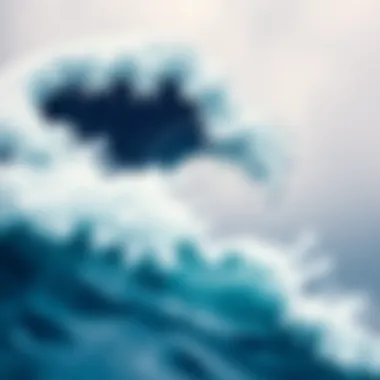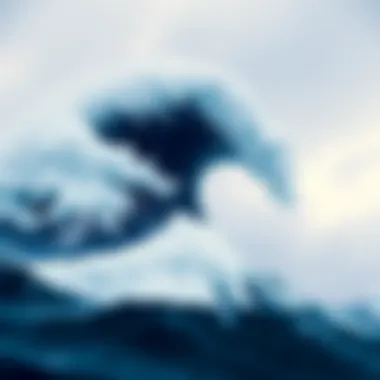The Great Wave Painting: Art, Culture, and Its Influence


Intro
Art has a way of reflecting the times, and few pieces do it as strikingly as Hokusai's The Great Wave off Kanagawa. Painted in the early 1830s, this woodblock print offers a window into Japan's cultural landscape during the Edo period. The magnificent wave itself serves as both a literal and metaphorical barrier—representing nature's overwhelming power as well as humanity's struggle against it.
In today’s world, this work is recognized far beyond its original context. It resonates in various forms, from tattoos to merchandise, and it often finds a place in the hearts of both art enthusiasts and the general public alike. This article will explore the intricate layers of artistic techniques and cultural narratives intertwined in this masterpiece.
We’ll venture into the historical context that birthed this iconic piece, the innovative methods Hokusai employed, and how its themes of nature and human experience continue to echo today. Each section will pave the way for a deeper understanding of not just The Great Wave, but the intricate relationship between art and culture as it adapts through time.
As we dive deeper, we’ll also highlight the valuable insights from art experts, outlining the current trends in interpreting classic art in a modern setting. Furthermore, we’ll discuss the broader implications of Hokusai's work on contemporary styles, as well as how it affects various cultural dialogues.
This exploration is an invitation to reflect on what art signifies in our lives today, making it relevant and precious just as it was over two centuries ago.
Historical Context of The Great Wave
Understanding the historical context of The Great Wave off Kanagawa is crucial for interpreting its significance and the impact it has had over the years. The painting by Katsushika Hokusai is not merely a representation of a wave; it embodies the ethos of the Edo Period in Japan, a time characterized by peace, stability, and significant cultural flourishing.
The Edo Period and Its Influence on Art
The Edo Period, spanning from 1603 to 1868, was a time where Japan experienced relative peace under the Tokugawa shogunate. This era allowed for a remarkable expansion of commerce, art, and culture.
- Artistic Freedom: Artists flourished during this time. Traditional forms of art like ukiyo-e, which translates to "pictures of the floating world," became immensely popular. Hokusai, along with his contemporaries, tapped into this freedom, creating art that challenged conventions and appealed to a wide audience.
- Manifestation of Nature: Nature was central to the artistic expression of this period. For example, Hokusai’s Thirty-Six Views of Mount Fuji includes the Great Wave, blending natural landscapes with human life. This reflects a growing appreciation for the environment and the understanding of humanity’s place within it.
- Cultural Exchange: The Edo Period was marked by increasing contact with the West, introducing new ideas and aesthetics that influenced Japanese art. This period laid the groundwork for The Great Wave, showcasing a blend of indigenous themes and external influences, which contributed to its enduring legacy.
Hokusai's Life and Artistic Background
Katsushika Hokusai’s life trajectory mirrors the evolution of art during the Edo Period. Born in 1760, he began his career as an apprentice at a young age, crafting his skills in various artistic forms, from painting to woodblock printmaking.
- Diversity in Style: Hokusai’s body of work is varied, showcasing his versatility. He evolved through many styles, influenced by his society and personal experiences, which gave his creations a unique quality.
- Personal Struggles: Hokusai faced numerous challenges throughout his life, including financial instability and loss. These struggles, often reflected in his work, add depth to the understanding of The Great Wave, which can be viewed not just as a literal wave but a metaphor for the vicissitudes of life.
"Art is never finished; it is only abandoned." - Hokusai
As we explore this piece's historical context, we will uncover how the socio-political landscape, along with Hokusai’s personal journey, coalesced to give rise to one of the most iconic images in art history. Understanding this backdrop even enriches the experience for athletes and recreationists today, as the connection to nature resonates across all walks of life.
To dive deeper into the even broader context, readers may consult resources such as Britannica for historical insights, or explore the dimensions of Hokusai’s work on Wikipedia.
Through this examination, the importance of the Great Wave emerges not as a singular phenomenon but as a cultural artifact grounded in Japan's historical narrative, showcasing the intricate interplay between society, environment, and artistic expression.
Artistic Techniques Used in The Great Wave
Artistic techniques play a pivotal role in the creation of any masterpiece, and The Great Wave off Kanagawa by Hokusai is no exception. The specific methods and materials employed not only enhance the visual appeal but also convey deeper meanings and cultural significance. In this section, we will explore the innovative woodblock printing methodology that brought this iconic image to life, alongside the vibrant use of color and composition that characterizes the piece. Each technique reveals the thought process of Hokusai and his intent, ultimately influencing both his contemporaries and future generations of artists.
Woodblock Printing and Its Methodology
Woodblock printing is the backbone of the artistry displayed in The Great Wave. This technique, known as ukiyo-e, involves carving an image into a block of wood, applying ink, and then pressing the paper onto the block to create prints. Hokusai utilized this time-honored method with an exceptional level of mastery. He carved multiple blocks for each color, starting with lighter shades and layering darker hues for depth. This process demands both precision and patience, qualities evident in the intricate details of the waves and the distant Mount Fuji.
What sets Hokusai apart in his use of woodblock printing is his innovative approach to color registration. Unlike many artists before him, he experimented with overlapping colors, a method that added a unique vibrancy to his prints. This is especially noticeable in the turbulent waves, which seem to dynamically move and swirl. The contrast between the deep indigo of the water and the pale foam showcases not only the power of nature but also the artist's technical prowess. The way the blocks are aligned and layered reflects a harmonious understanding of depth and texture in printmaking.
The Use of Color and Composition
The color palette in The Great Wave has been a topic of discussion among art critics and enthusiasts alike. Hokusai predominantly employed indigo, a color derived from the fermented leaves of the indigo plant, which was uncommon and expensive at the time. This choice conveys the raw intensity of the ocean, creating a visually striking contrast against the lighter tones used for the foam and sky. Such vibrant use of colors demonstrates Hokusai's ability to evoke an emotional response from viewers, provoking feelings of awe mixed with trepidation about nature's might.
Additionally, the composition itself is masterful. Hokusai's use of diagonal lines creates a sense of movement and urgency within the scene. The wave arches dramatically, leading the eye towards the distant Fuji, anchoring the composition. This arrangement not only directs focus but also symbolizes the relationship between humanity and nature—representing the indomitable force of the sea against the tranquil presence of the mountain. The careful balance between chaos and order in this artwork invites myriad interpretations of strength, vulnerability, and the sublime.


"The Great Wave encapsulates a perfect union of artistic technique and thematic depth, echoing the cultural narrative of resilience in the face of nature's fury."
In sum, the artistic techniques employed in The Great Wave are not merely about creating a visually appealing print; they serve a larger purpose of storytelling and emotional expression. From woodblock printing's intricate process to Hokusai's deliberate use of color and composition, each element is meticulously crafted to resonate with audiences. The impact of these techniques is evident, influencing artists through the ages and contributing to the painting's status as a cultural icon.
Thematic Elements in The Great Wave
The thematic elements in The Great Wave off Kanagawa are crucial for understanding not just the painting, but also the cultural undercurrents it represents. The painting transcends mere aesthetics, working as a visual narrative that captures the complex relationship between humanity and nature. This section will delve into two primary themes: the overwhelming power of nature and the symbolic representation of water within Japanese culture. By unpacking these elements, we can gain a deeper appreciation for how Hokusai’s masterpiece continues to influence art, culture, and thought across diverse contexts.
Nature’s Power and Human Vulnerability
In the frame of The Great Wave, the clash between the colossal wave and the small boats conveys a dramatic narrative. Nature's might is vividly depicted, and this not only serves to highlight human vulnerability but also to explore the existential struggle of life itself. Hokusai’s portrayal of the wave rising majestically encapsulates nature's unpredictability. This thematic dichotomy between humanity's fragile existence and the overwhelming force of the natural world is apparent in every brush stroke.
The eight fishermen, battling the waves, symbolize human endeavor against insurmountable odds. They illustrate the timeless challenge faced by mankind: navigating obstacles that can seem insurmountable.
"The Great Wave is not merely about the rise of a wave; it's a reminder of our constant struggle for survival amidst forces greater than ourselves."
Moreover, this theme resonates with modern audiences, especially within sports and recreation communities who regularly confront natural elements in various forms, whether it's surfing, sailing, or other outdoor adventures. Individuals in these activities often find themselves in precarious conditions, mirroring the experience of Hokusai’s fishermen. This timeless parallel draws connections between viewers and the artwork, further expanding its relevance.
Symbolism of Water in Japanese Culture
Water holds a rich tapestry of meanings within Japanese culture, serving as a powerful symbol that encompasses purification, renewal, and the fluidity of life. In The Great Wave, the water is more than just a backdrop; it is alive, dynamic, and integral to Japan's identity. Traditionally, water has been viewed as a life-giving force, often associated with Shinto beliefs where it embodies purity.
The undulating forms of the waves symbolize change and impermanence—a core tenet of Japanese philosophy. This notion intertwines with the idea that nothing is ever truly stable; everything is in a constant state of flux.
In recreational activities, such as kayaking or enjoying a day at the beach, participants often engage with water as a symbol of freedom and release. This connection attests to the ingrained role water plays in both culture and recreation, echoing Hokusai's insights on existence. The Great Wave brings those feelings to the foreground, pushing us to acknowledge not only the joy found in natural interactions but also the respect and caution such encounters demand.
In summary, the thematic elements of The Great Wave highlight nuanced conversations about nature’s challenge to human existence and the cultural significance of water, shaping not just the artwork itself but also the dialogues it inspires in today's context. Understanding these themes allows readers and audiences, especially those engaged in athletic pursuits, to reflect on their place within the broader tapestry of life and culture.
Cultural Significance of The Great Wave
The Great Wave off Kanagawa, painted by Hokusai, transcends mere aesthetics; it serves as a cultural beacon that reflects the complexities and nuances of Japanese society and its relationship with nature. The significance of this artwork goes beyond its beautiful portrayal of a massive wave crashing against boats; it encapsulates essential themes of vulnerability, resilience, and humanity's place within the broader natural world. This section will explore the depth of its impact on Japanese art and its wider cultural implications.
Impact on Japanese Art and Beyond
Through the lens of The Great Wave, one can see not just the talent of Hokusai but also the seismic shifts within Japanese art during the Edo period. The painting has been instrumental in shaping the subsequent generations of artists in Japan. It symbolizes the transition from traditional monochromatic ink paintings to a vivid world where color enhances emotional expression.
Artists such as Katsushika Hokusai opened doors to a new era, influencing both local and international art scenes. For instance, Claude Monet and Vincent van Gogh, two giants of Western art, cited Hokusai's work as foundational to their own styles. The unique techniques of ukiyo-e, as exemplified in The Great Wave, began to meld with Western perspectives. This intermingling fundamentally altered the art landscape, leading to a cross-pollination of ideas that continues to inform contemporary art practices.
Moreover, The Great Wave represents a collective consciousness in Japan. It’s more than a painting; it's a shared cultural artifact that resonates deeply with Japanese identity. This piece has evolved to embody both national pride and a reminder of nature's might, acting as a catalyst for artists who seek to express similar themes of fragility and strength. The very act of depicting nature as both a beautiful spectacle and a terrifying force is something that resonates deeply within Japanese philosophy and consciousness.
The Wave as a Cultural Icon
Notably, The Great Wave has transcended its status as just an artwork; it has become a cultural icon recognized worldwide. Its presence spans various mediums—from fashion to digital art, reinforcing its relevance in contemporary society. You will find its visage on everything from T-shirts to high-end art installations. The wave’s distinctive shape has been incorporated into logos, ceramics, and even tattoos, making it an emblem of beauty and struggle.
"The Great Wave illustrates both nature’s grandeur and human vulnerability—qualities that resonate deeply across cultures."
The symbolism that this painting encapsulates is profound. For athletes and adventurers, it serves as a metaphor for battling the odds, overcoming challenges, and embracing the uncertainty that often accompanies pursuits in nature. It inspires individuals to confront their challenges head-on, much like the boats riding against the imposing wave.
Furthermore, this artwork has spurred dialogues surrounding environmental issues. As global conversations shift toward sustainability, The Great Wave stands as a poignant reminder of nature's raw power and the respect it demands. Its imagery speaks to the necessity of balance between human demands and the environment, prompting critical reflections in various circles, including those interested in environmental activism and outdoor sports.
The Great Wave in Contemporary Art
The significance of The Great Wave off Kanagawa in contemporary art cannot be overstated. This iconic piece has transcended time, permeating various art forms and influencing countless artists. Its distinct blend of traditional aesthetics and universal themes of nature continues to resonate, prompting modern creators to engage with its rich symbolism and profound emotional depth.


Influence on Modern Artists
Hokusai’s The Great Wave is a rite of passage for many modern artists. The colossal wave, with its fierce curl and dynamic energy, serves as a source of inspiration for those exploring themes of nature and humanity. Artists such as Takashi Murakami have directly cited Hokusai as a significant influence, often incorporating similar waves or aspects of traditional Japanese art into their contemporary works.
These modern interpretations, while diverging from Hokusai's precise techniques, maintain a dialogue with the original piece, presenting it in new contexts. For instance,
- Installation art often incorporates the imagery of waves to evoke feelings of power and vulnerability, mirroring Hokusai's message about nature’s untamed force.
- Street artists may reimagine the wave in urban environments, creating an intense contrast between nature’s grandeur and the gritty backdrop of city life.
The exchange of ideas between The Great Wave and modern art demonstrates how timeless themes can inform and rejuvenate artistic dialogue across cultures and eras.
Reinterpretations in Popular Culture
The cultural impact of The Great Wave extends far beyond the confines of traditional art galleries. In popular culture, it has found itself everywhere from fashion to film, often reinterpreted to resonate with contemporary audiences. This versatility speaks volumes about the work’s deep-rooted themes.
- Fashion: Designers like Comme des Garçons have used the wave as a motif in clothing collections, merging art and fashion while provoking discussions around nature and human experience.
- Film: The powerful imagery of the wave has inspired scenes in animated movies and video games, serving as an allegory for challenges faced by protagonists. For example, in animated films, characters often confront waves as metaphors for their struggles.
Through these reinterpretations, The Great Wave remains relevant, allowing each generation to reframe its meaning according to contemporary contexts and values. The ability of this artwork to adapt and maintain significance illustrates art's role as a living, breathing entity in society.
The ability of Hokusai's masterpiece to be interpreted in diverse ways ensures its place in the dialogue of modern creativity. Whether in the streets or on the runway, it continues to inspire us to rethink our relationship with nature.
In summary, the influence of The Great Wave off Kanagawa in contemporary art is a testament to its enduring power. It invites artists and audiences alike to reflect on their existential reality amid nature’s unfathomable force. This dialogue shapes the evolving landscape of art and culture, proving that some works are destined to span generations.
Critiques and Interpretations Over Time
Examining critiques and interpretations of 'The Great Wave off Kanagawa' offers valuable insights into how our understanding of art evolves over time. This legendary piece by Hokusai stands not just as a representation of nature’s mighty force but as a mirror reflecting societal changes and cultural shifts. Throughout its history, the wave has provoked discussion, admiration, and scrutiny, becoming a pivotal subject in the dialogues around art theory and cultural analysis.
Art Historical Perspectives
The wave has transcended its initial creation in the 1830s, evolving through various interpretations by art historians and critics alike. The influence of this work is traced through numerous art movements, from Impressionism to the modern age, where it is often regarded as a defining moment in ukiyo-e art. Notably, Western artists during the 19th century began to explore Japanese aesthetics, partly catalyzed by Hokusai's profound impact.
- Influence on Impressionism: Artists such as Claude Monet and Vincent van Gogh borrowed elements from Japanese prints, including perspective, composition, and the boldness of color. The Great Wave's dramatic depictions of nature influenced not only landscapes but the entire approach to artistic expressions of emotion.
- Symbolism in Art History: Scholars have often delved into the symbolic dimensions of the wave. Some interpretations link it to the concept of impermanence, a fundamental belief in Japanese philosophy, while others discuss how the wave stands as a metaphor for the unpredictability of life itself.
- Diverse Academic Discourse: The painting has sparked a multitude of academic essays and books, elaborating on various themes—from the interplay of human craftsmanship and natural chaos to the commentary on socio-economic conditions of the Edo period. The multiplicity of views demonstrates its rich layers of meaning.
The Wave in Art Criticism
Critics over the years have analyzed Hokusai's work through various lenses, articulating both admiration and caution regarding the interpretations of the piece. Contemporary critics often adopt a more nuanced approach, reflecting on how the wave intersects with environmental consciousness and cultural identity.
- Critical Acclaim: The Grand Wave often garners praise for its technical brilliance and emotional depth. Critics have pointed out how Hokusai managed to imbue physical phenomena with a sense of aesthetic beauty, inviting viewers to feel the palpable tension between man and nature.
- Cultural Recontextualization: In recent years, critics endeavor to place The Great Wave within the context of contemporary environmental debates. The wave serves both as a harbinger of nature's fury and a reminder of humanity's vulnerability to ecological shifts. This dual perception has propelled discussions about climate change into artistic forums previously reserved for aesthetic appreciation.
“The Great Wave is not merely a painting; it is an ongoing dialogue between nature, culture, and the human spirit.”
In summary, delving into critiques and interpretations reveals how 'The Great Wave off Kanagawa' continues to resonate with various audiences, serving as both a historical artifact and a present-day commentary on our relationship with the world around us. As such, it underscores a vital aspect of how art remains dynamic, always open to new perspectives and meanings.
The Great Wave and Environmental Themes
The Great Wave off Kanagawa stands as more than a mere aesthetic marvel; it invites contemplation on the broader themes of environmental consciousness. In an era marked by escalating climate challenges, the painting serves as a poignant reminder of nature's might and the fragility of human existence. This section endeavors to dissect the interplay between the artwork and vital ecological themes, profoundly relevant to both leisure enthusiasts and professionals alike.
Nature’s Role in Human Survival
When closely observed, The Great Wave highlights nature's overwhelming power. In Hokusai's masterful portrayal, the soaring waves seem ready to engulf everything in their path—a reminder of the sublime force that nature embodies. The wave functions as a metaphor for the challenges facing humanity in the context of environmental fluctuations.
Nature, often viewed as an external entity, is inextricably linked to human survival. We rely on it daily, whether it be through the resources provided or the emotional solace it brings during trying times. The Great Wave encapsulates this dual relationship: while it instills awe, it equally elicits respect for the elements that sustain life. As athletes and outdoor enthusiasts thrash through waves, their actions echo the sentiments expressed in Hokusai’s artwork. It urges a reflection on whether we can maintain a harmonious relationship with the environment, resisting the urge to conquer rather than coexist.


"We live in an age where humanity’s choices define nature’s paths, as starkly illustrated by echoes of the 19th-century artist’s insight."
Contemporary Environmental Movements
The canvas of The Great Wave extends beyond its 19th-century origins; its contemporary resonance finds a place in modern environmental activism. Various movements have arisen, taking cues from the depth of nature depicted in the painting. Today's environmental advocates emphasize sustainability, urging society to recognize that the earth is not merely a resource to exploit but a complex ecosystem to maintain.
Many organizations draw inspiration from Hokusai's imagery, grounding their campaigns in visual persuasion. The Great Wave often appears in environmental art installations and campaigns aimed at raising awareness about rising sea levels and climate change. This substantial shift in narrative—from viewing nature as a backdrop to acknowledging it as a vital part of our narrative—demands attention.
Furthermore, education around these themes has surged, with art educators implementing The Great Wave in curricula to highlight the importance of our connection to nature. The topics of sustainability and ecological preservation have become vital discussions. Hokusai's painting transitions from merely beautiful artwork to an emblematic voice in the environmental arena. The emphasis on preserving our planet speaks directly to athletic communities, where the thrill of nature propels sports like surfing, kayaking, and more. By engaging with this piece, athletes and coaches have an opportunity to call for responsible stewardship of the environments they cherish.
In summary, The Great Wave not only represents artistic innovation but also serves as a clarion call for contemporary environmental consciousness. The legacy of Hokusai's work continues to inspire leaders in environmental thought and action, making this artwork an enduring influence not just on culture but on the very essence of our existence with the natural world.
The Great Wave in Education
The Great Wave off Kanagawa has carved out a place in the educational landscape, blossoming into a rich subject for both art and cultural studies. It serves not just as a centerpiece within art curricula but also provides a broader canvas for discussions about nature, human interaction, and societal influences. By engaging with Hokusai's masterpiece, educators can help students grasp more than just aesthetic appreciation; they can explore the myriad influences art has on culture, identity, and environmental consciousness.
Utilization in Art Curricula
Incorporating The Great Wave into art curricula offers students an opportunity to understand and appreciate the technical brilliance behind woodblock printing, a signature technique of Hokusai. This artwork acts as a gateway, drawing students into a world where they can learn about traditional Japanese art forms. Students can practice their skills by creating their own woodblock prints, engaging in hands-on activities that mirror Hokusai’s techniques. It allows them to appreciate the intricacy of color layering and composition firsthand.
Additionally, analyzing the visual elements of The Great Wave fosters critical thinking. Students discuss and dissect how Hokusai navigated balance and rhythm, examining how these elements convey powerful themes. This discussion leads to questions about the time period's environmental relationship, prompting deeper thought about how art reflects the world it emerges from. Being a part of this learning journey prepares students to see the wider implications of their own artistic choices, establishing a bridge to contemporary art practices.
Engagement with Art History
The educational importance of The Great Wave extends beyond its technical aspects; it also encapsulates various facets of art history. Exploring this work allows students to connect with the Edo Period, understand its ideologies, and how they shaped artistic expression. By studying Hokusai's influences and contemporaries, learners can contextualize the artwork in broader historical narratives, shaping their understanding of cultural exchange and evolution in art.
Art history lessons that include The Great Wave illustrate the transformation of artistic themes through time, highlighting how nature serves as a muse across different cultures. Engaging students with questions about water’s symbolism and its impact on human life creates an interactive atmosphere where discussions on climate change and environmental awareness can thrive.
"The Great Wave is more than a visual spectacle; it’s a lesson in resilience—reminding us that nature's beauty carries both power and peril."
This educational approach fosters not just artistic literacy, but also instills a sense of global citizenship among students. They are encouraged to see their role within the environmental context as they build on the foundations established by Hokusai. This serves to inspire future artists and environmentalists alike, ensuring that the legacy of The Great Wave continues to resonate in diverse discussions, drawing personal connections to their own lives and communities.
Through this educational lens, The Great Wave off Kanagawa doesn't just remain an artwork in a textbook; it becomes a pivotal part of conversations on art, culture, and the environment, instilling a lasting sense of curiosity and engagement.
For further exploration, you may refer to resources like Wikipedia and Britannica.
As students engage with Hokusai's masterpiece, they not only learn about art history—they are also compelled to reflect on their place in a constantly changing world.
End: The Enduring Legacy of The Great Wave
As we draw the curtain on our exploration of Hokusai's monumental work, The Great Wave off Kanagawa, it's essential to reflect on its enduring legacy. This artwork, painted in the early 19th century, is not just a depiction of nature’s fury but a canvas that speaks to the human condition, our vulnerabilities, and our resilience in the face of overwhelming forces. The wave has become more than just a piece of art; it symbolizes a cultural ethos that transcends borders and time, influencing various aspects of society, from artistic expression to environmental awareness.
Reflection on Artistic Impact
Looking back, Hokusai’s mastery resonates through countless art movements. The prints have inspired artists worldwide. It is not merely the action of the wave that captivates us but also how Hokusai plays with form and color. His deliberate use of bold lines, combined with a palette that captures the subtleties of the ocean, invites viewers to experience both beauty and terror. The reproduction of this image across various mediums showcases its adaptability and the universal themes it encompasses—conflict, nature, and the smallness of humankind in the face of the vast universe.
The Great Wave has intertwined with several art forms, influencing impressionists like Claude Monet and contemporary street artists. Thus, its artistic impact is akin to a ripple effect; just like the waves themselves, its reach expands in directions we can't always see. The work has elevated discussions around the artistic processes, emphasizing how context, technique, and innovative artistry coalesce to generate timeless pieces that touch the human soul.
Future Implications for Watersports Enthusiasts
For those of us drawn towards activities like surfing, sailing, or even coastal conservation, The Great Wave serves as both a reminder and a beacon.
- Connection to Nature: It symbolizes the unpredictable beauty of the sea, urging enthusiasts not only to appreciate nature but to learn from it—understanding that the water can be a friend and a foe.
- Inspiration for Design: Many modern watersports equipment designers have drawn from the aesthetics of Hokusai’s wave, creating boards and sails that express both functionality and elegance— marrying tradition with innovation.
- Environmental Advocacy: The legacy of the wave naturally ties into discussions surrounding climate change and ocean conservation. As athletes, the connection to the sea compels a responsibility to advocate for its health, reflecting the artwork's thematic essence of nature's power—an indelible reminder of our role as stewards.
In considering these factors, we realize that The Great Wave becomes more than just an image; it embodies a call to action for anyone with a passion for water. As we navigate the waters of our respective fields, the painting’s legacy propels us forward, encouraging both reverence for the ocean and a commitment to protect its majesty.
The Great Wave is a canvas that captures not only the essence of art but also the essence of life itself—beautifully complex and steeped in meaning.
In summary, Hokusai's work encourages ongoing dialogue and reflection on art, culture, and the superior forces of nature. Its legacy, thus, remains vibrant and ready to inspire the next generation, ensuring that this cultural treasure maintains its relevance amid the rising tides of our changing world.







